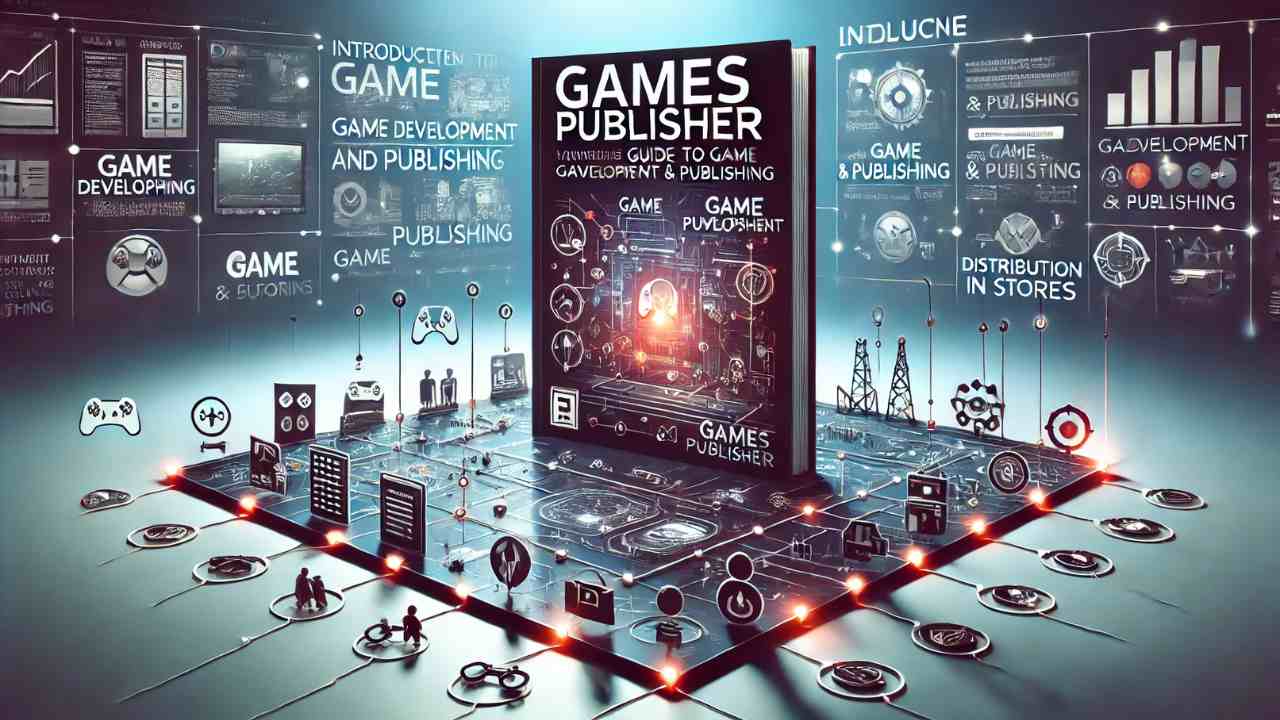Game development and publishing must work together, which is crucial to the video game industry.
Game development involves creating the game itself, from ideas and programming to all aspects, while game publishing ensures global delivery to players.
This guide will focus on what you should know within the game development and publishing industry and arm you with the best practices essential in this ever-expanding niche.
Understanding Game Development
Video gaming development involves designing video games, from conceptualizing the idea to development to coding, testing, and marketing.
But first, let’s see some of the key roles in video game development!
Key Roles in Game Development
The development of a successful video game requires the contribution of several professionals, including:
Game Developer
Game developers are not only the ones who carry out the initial idea but are also the leading players of the game and coordinate the entire process.
They consult with other team members to determine their thoughts about the game.
Game Designer
The game designer is the person who controls the game environment, creating all the tactics on a level, all the characters, and many other elements.
They build an excellent playground to keep gamers glued to the screen.
Game Artist
Game artists design the aesthetics of the game environment, game characters, and everything that appears in the game.
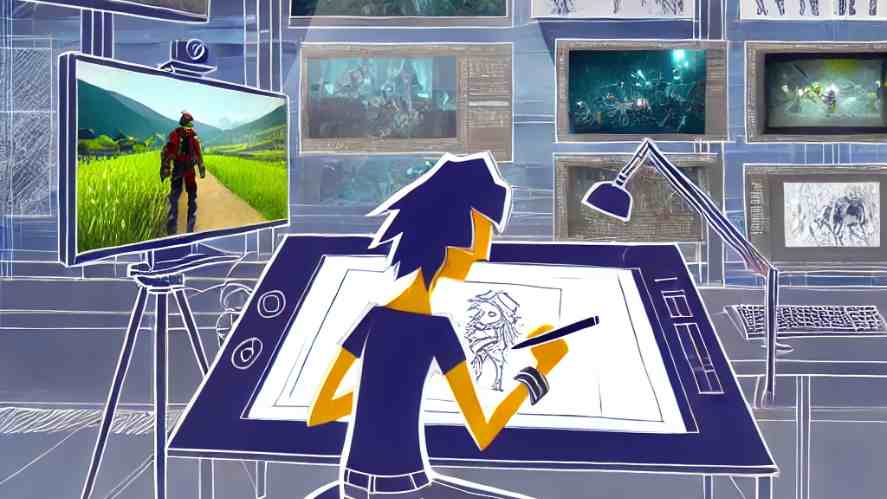
Some of their tasks involve concept art, simple visuals, 3D modeling, and animation, contributing to the game’s style and aesthetic.
Game Programmers
Game programmers write the code to make the game work.
They bring that vision down to an accessible and usable form and ensure the game plays fluently and responsively.
Game Tester
Testers play the most crucial role in creating the game, yet their tasks are essential.
They play the game and try to find some of its flaws, such as bugs or lost objects. Players can give some of the most helpful input regarding the presentation and overall game experience.
Game Development Process
Game development is the process of creating a game and takes a series flow chart for the final structured game that is united, smooth, and attractive.
Let’s take a closer look at the critical phases involved!
Concept and Planning
This is the first phase, and it focuses on creating the game concept, although the idea does not refer to a single term in most cases.
Strategy formulation entails ideation, identifying the target market, and completing market analysis to predict the game’s success correctly.
Pre-production
Once the concept development is complete, the production process commences with pre-production.
This involves designing storyboarding for the game’s narrative, for instance, designing prototypes that represent the game features, which are then used to test out features on the game, preparing the game.
This stage involves analyzing the game story to create sequences of events and identify potential incidents in the game.
Moreover, it also involves creating paper and digital prototypes for designers to develop gameplay and prepare a game proposal outlining the conceptual and technical features of the game.
Production
This is the process of actual creation, making the main fabric of the game where everything starts to look like a game.
While the coders design the game’s flow, artists provide eye-pleasing graphics, and sound practitioners work on audio effects, level designers are charged with designing challenging levels for gameplay.
Testing
During this phase, the game is tested continuously to reveal any residual defects or issues that could prevent the players from enjoying the game as they should.

QA becomes a crucial factor in the development process as the teams need to ensure the game matches the company’s standards of quality in terms of stability, visuals, and performance.
Post-production
After the game has been released, more work often goes into ensuring the game stays fresh and continues to attract attention.
Post-production is delivering patches and updates for the remaining defects or coming up with new content, such as downloadable content (DLCs), to sustain the fascination and continuously get the consumers to play the game.
Introduction to Game Engines
Game engines are platforms for building games. It helps developers not to waste time thinking of technicalities but rather their creative part.
What is a Game Engine?
A game engine is a development consisting of software tools that assist video game developers complete the process more efficiently.
It offers a collection of appropriate tools and options, which include rendering toolkits and motors, physics toolkits and motors, sound system support, and script interfaces, which developers can use to develop their games.
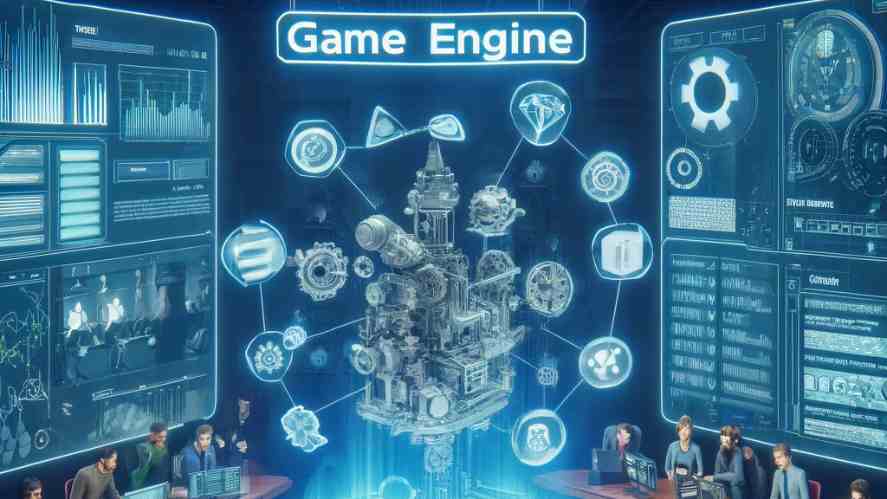
That said, selecting an appropriate game engine during development is one of the critical aspects of any game development.
While choosing the game engine, one must consider the type of game, the intended market, the cost, and the competency or proficiency of the development team in using the game engine.
Popular Game Engines
Over the recent years, some game engines have emerged in the industry and developed various strong and capable features to suit development requirements.
Let’s look at some of the most popular engines:
Unity
Known for its user-friendly interface and versatility, Unity is a popular choice for beginners and experienced developers.
It offers a vast asset store, a robust scripting system, and excellent cross-platform compatibility, making it ideal for developing games across various devices.
Popular titles like Cuphead, Ori and the Blind Forest, and Hollow Knight were all created with Unity.
Unreal Engine
Unreal Engine is a powerful tool for visually stunning games.
It’s a collection of tools for creating realistic environments, complex animations, and dynamic lighting effects.
Games like Fortnite, Gears of War, and Hellblade: Senua’s Sacrifice showcase the graphical prowess of Unreal Engine.
Godot
A free and open-source engine, Godot is gaining popularity among indie developers due to its flexibility and ease of use.
It offers a node-based visual scripting system, a rich set of 2D and 3D tools, and excellent performance.
While not as feature-rich as Unity or Unreal Engine, Godot is a great starting point for aspiring game developers and those working on smaller projects.
Pros and Cons of Different Game Engines
Each software has advantages and disadvantages that make it optimal for specific projects and teams.
Unity
- Pros: Good and interactive GUI, large asset store, intensive social support, multiplatform, and visual programming.
- Cons: C# scripting can be challenging for beginners.
It offers the most straightforward tools and an astounding asset store, so Unity suits inexperienced indie developers.
Moreover, it also has a visual scripting option and good support from the community.
The problem with C# scripting is that a start programmer might find it challenging. In addition, maybe for massive projects, the performance can slow down quite a lot.
Unreal Engine
- Pros: Powerful graphics capabilities, advanced features, blueprint visual scripting, ideal for high-fidelity AAA game development.
- Cons: Steeper learning curve, larger project sizes, can be resource-intensive.
Unreal Engine, on the other hand, is well known for its powerful graphics engine and additional features and for being a powerful and big 3D engine preferred for high-standard games.
With its easy-to-use visual scripting system, the blueprint enables the fast creation of unique levels and scenarios ideal for experimenting and tweaking, even by those who don’t know how to code.
However, compared to Unity and Godot, Unreal Engine has more difficulty in the learning curve, and projects composed with Unreal Engine are likely to cost more.
Godot
- Pros: Fully portable, free, and open source, suitable for 2D and light 3D games.
- Cons: Smaller community than Unity or Unreal Engine, fewer features and assets.
Godot is free and open-source for indie developers and teams with little to no budget.
However, due to competition with Unity and Unreal Engine, their population size is significantly low, and therefore, there are limited resources and assets.
Ultimately, the choice of the game engine depends on your specific project requirements, budget, team size, and technical expertise.
By carefully evaluating the pros and cons of each engine, you can select the one that best aligns with your vision and goals.
Game Publishing: An Overview
Video game publishing entails the final stages of a video game’s production, involving advertising, delivering, selling, and other related services.
The role of a publisher is to coordinate developers and players and solve all the business and organizational issues related to a game.
This enables the developer to focus on crafting the game while the publisher deals with aspects of the business.
Publishing, or the primary responsibility of game publishers, also entails forming retail and distribution partnerships to ensure the availability of games to the public.
They have the marketing skills and capital to develop attractive trailers to help popularize a game before it is out.
Steps in the Game Publishing Process
Game publishing is a multi-faceted process that can be broken down into three main stages: pre-launch, at-launch, and post-launch.
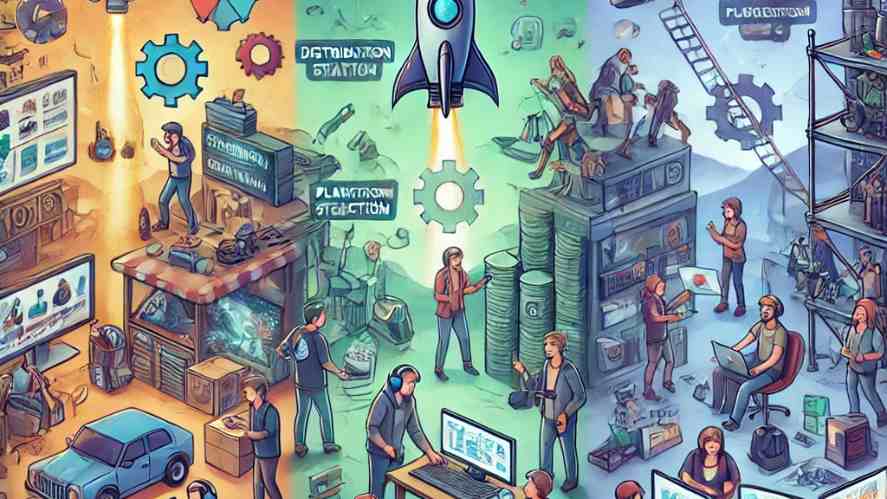
They all have essential roles in achieving the goals and making the game successful and sustainable in the market.
Pre-launch
This phase involves creating awareness of the game and fueling the consumers’ desire to own and play the game.
Companies spend a lot of money to promote the game through viewer videos, teasers, and game demos.
They also rely on loyalty by creating a community via social media platforms, online communities, and word-of-mouth influence.
Utilizing platforms like GamePublisher.com can also help indie developers find the right publishers to support their marketing efforts.
Launch
This is the point where the game is out; everyone can play it, including the target demographic.
Distribution channels, such as video game digital platforms like Steam or specific console marketplaces, are chosen wisely.
Its timing is essential and is arranged for periods with the best effect in terms of playing amount, excluding periods when the other studios release their masterpieces.
Post-launch
It does not stop even after the game has been created.
After the launch, the players have to be retained as well, and the game’s life span has to be elongated to have value added to it.
As in previous years, the publishers maintain a presence in social networks, forums, and regular meetings.
They also provide gamers with updated patches and extra data to fix problems, enhance gameplay, and interest gamers in carrying on with the game.
It can only be known that long-term support helps create a fan base and ensure the continuation of the game’s success.
Self-Publishing vs. Traditional Publishing
In the ever-evolving game development landscape, developers face an important decision.
One is that they can self-publish, and the other is that they can cooperate with regular publishing companies.
Both paths have benefits and risks that customers, employees, or any other stakeholder must consider.
Self-Publishing
Benefits
- Gives game developers complete control
Challenges
- No time and resources to properly market their games
- Hard to recruit members for a community
- Hard to distribute the final product
- Lack of financial capital and networking contacts
Traditional Publishing
Advantages
- Has financial support
- Has connections that increase the game’s visibility
- Has support in marketing and localization
- Has support with legal issues
Disadvantages
- Publishers take a portion of the game’s profit
- Complex launching process can lead to the game’s delay
Read More: What Does a Game Publisher Do?
Marketing and Monetization Strategies
In the context of the current competition in video games, these two factors play critical roles in the video game: the right marketing strategy and a proper way of monetizing.
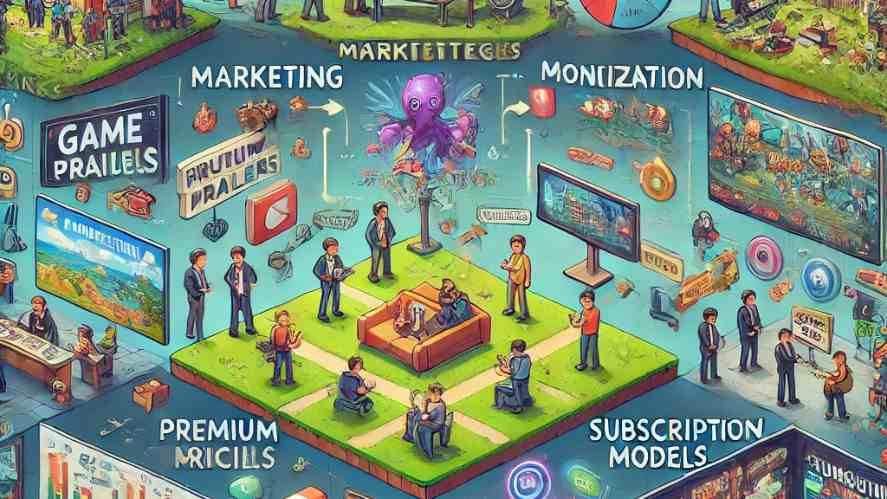
Marketing Strategies for Games
Marketing is an essential tag in the success of any game, especially in the creation of awareness, the generation of hype, and the encouragement of people to play the games.
Here are some key marketing strategies that game developers and video game publishers can utilize.
Building a brand and online presence
Develop the right corporate image, which includes defining a proper logo, visual design, and language that will interest the target audience.
Update the performers’ official site and social networking accounts to keep live links and fan discussions.
Utilizing social media, influencers, and gaming events
Connect with the players on social media such as Twitter, Facebook and Instagram.
Collaborate with other influencers to reach more audiences and attend video gaming events to promote your game, make connections, and get valuable critiques.
Crafting a Nice game trailer and promotional materials
Make a non-obvious trailer that shows some distinctions and how it is to play through.
Accompany this with other promotional items such as screenshots, artworks, and press releases to climate in the much-needed media frenzy.
Monetization Models
The type of monetization chosen has critical importance, not only for the financial structure but for the very existence of a video game.
Several foremost models provide various strategies for generating revenue, both with benefits and drawbacks.
Free-to-Play (F2P) with In-App Purchases (IAP)
Usually, the game is downloadable for free and open for playing. Still, there is always an opportunity to purchase virtual items for real money, for example, accessories or items for character customization, new levels, additional maps, etc.
It attracts a lot of players and can make a profit. However, strict moderation is needed to keep players from giving up.
Premium Pricing Model
Users buy the game at a 1-time cost, providing clear revenues for the players.
This model may dissuade people who are afraid of spending money on the game before they even have a chance to play it, but the best premium games offer excellent quality and a vast amount of content.
Subscription-Based Models
Consumers continuously purchase subscription fees, ranging from monthly to yearly, to play the game and content.
This model guarantees steady income, but the information should be renewed constantly to keep subscribers interested in a publication.
Hybrid Models and Evolving Trends
Many games try to combine the above methods to make more money.
For instance, a game may be available to download without cost, contain micro-transactions, and provide a paid version with extra goodies.
New trends have also emerged, including using blockchain in games and play-to-earn business models.
Many authors have confirmed that choosing a model that matches the game’s design is essential. In addition to bringing in sustainable revenue, it will positively impact the player experience.
Challenges in Game Development and Publishing
Whether it is developing a new game, fine-tuning the code, or marketing the game, several challenges always get in the way.
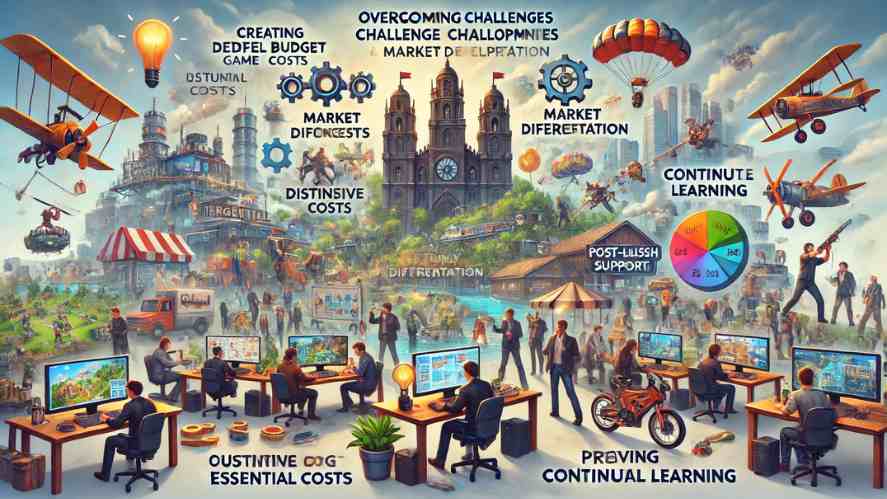
Technical Challenges
Since game development regularly incorporates coding, the technical problem is unavoidable.
Program flaws, or bugs and glitches, as well as the overall performance stability, are always issues that demand a rigorous testing and source code debugging process.
Furthermore, conforming to multiple platforms and devices may take more time and effort in the development process and more manpower.
Financial Challenges
Developing a game is never cheap, and funding is often the biggest challenge in this industry, especially when creating a product independent of the big publishing houses.
Financial constraints, as a limitation affecting the scope of a project, can affect the quality of assets that must be acquired and the promotion of the project.
Schedule variations and other disturbances can also pressure the financial capacity, so one should always have proper financial planning and emergency solutions.
Market Challenges
The gaming genre is most intense and unyielding due to the fierce competition for new titles.
It is necessary to have qualitative and distinguishing game concepts, good advertising techniques, and efficient web promotion.
Excess competition and shifts in players’ demands can also present risks, so game developers and publishers must find ways to respond creatively.
Eradicating these challenges requires technical skills, innovation, organization, financial management skills, and proper market strategy.
So, by being aware of these challenges, the likelihood of having a successful game being produced, developed, and bought by users in the unsteady world of game development will be higher.
Overcoming Challenges
It is essential to realize that failure is inevitable in the game development and publishing processes.
There are ways to cope with such failures for the company to succeed.
Tips for managing a game development budget
To manage money concerns of game development, the first and most essential step is to set funding, which is the estimated total sum of activities for salary, software, advertisement, etc., and probabilities.
Next, priorities should be set on essential aspects of the game that are necessary for its core experience. You should avoid adding features that will exceed the resource limits.
Thirdly, the cost can be cut by employing free or cheap resources from the internet, including an open-source game engine and other assets from fellow developers.
Another instance where outsourcing is also beneficial is in increasing the artwork and sound, as sometimes it is convenient to focus on core development only.
Strategies for standing out in a crowded market
To stand out in the market, your game should have a good idea that includes elements like good gameplay, an exciting plot, or the perspective from a different angle at existing types of games.
Party targeting is essential when you want the end users for the products or services to be specific parties.
Define your potential competitors, adapt marketing strategies to the players’ objectives, and implement social networks, influencers, and collaborative activities.
Moreover, the game should perhaps be released in a closed beta and give the gamers earliest access to the game to build up their interest towards the full version release.
It helps because you can experiment with it, gain data regarding its effectiveness, and introduce it to the gaming community.
Lastly, do not forget about post-launch support.
Additions, enhancements, corrections, and changes should be made periodically to maintain the interest of the old players and get more attention from new players.
Importance of continuous learning and adaptation
It is essential to be in line with these advances to survive some of the emerging trends in the gaming industry.
Continuing changes in technologies, platforms and players’ preferences are dynamic and occur frequently, this makes it difficult for developers and publishers to hold a competitive edge for too long.
It is also essential to learn from players by integrating their feedback into the game design and development processes.
Subscribing to players’ input, from compliance to modifications in gameplay, would improve the game and attract more players.
Moreover, do not fear the ‘not now and the not here’ syndrome, but be bold and experiment!
Testing something new and innovative will give you exciting and engaging games that will hook players and make them choose you instead of your competitor.
Conclusion
In short, game development and publishing are two different but closely intertwined aspects of the game industry. Each element is vital in taking a game from concept to market success.
Therefore, recognizing the importance of both aspects will enhance the ability to reach the pinnacle in this field for those who wish to become game developers and publishers.
You can visit Gamespublisher.com to learn and read more related and in-depth documents. We wish you success!
Loading survey...

